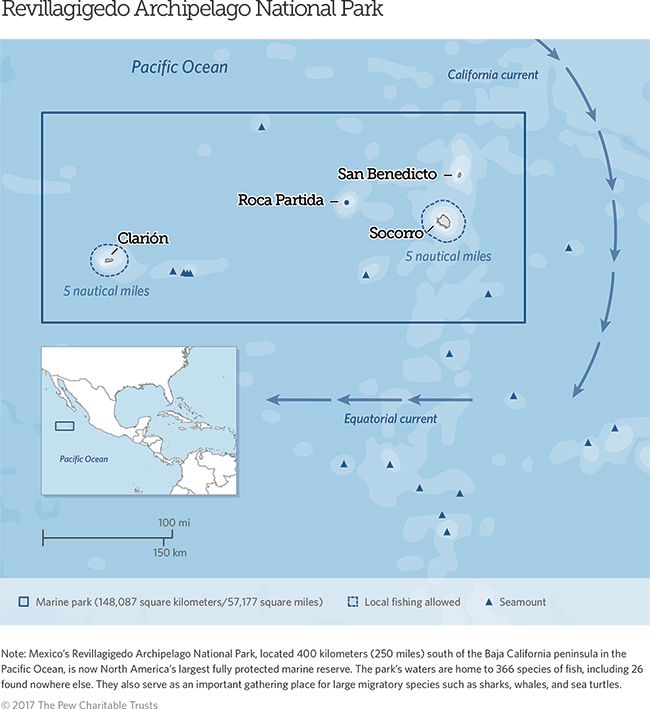Revillagigedo Archipelago
Waters around Pacific island group now make up Mexico’s largest fully protected marine reserve
This fact sheet has been updated on July 17, 2020, and can be found here.
Overview
The Revillagigedo Archipelago sits off Mexico’s Pacific coast, about 800 kilometers (500 miles) west of the city of Manzanillo and 400 kilometers (250 miles) south of Cabo San Lucas. With its rich ecological and geological landscape, the volcanic island chain was named a UNESCO World Heritage site in 2016.
The four uninhabited islands—Socorro, Clarión, San Benedicto, and Roca Partida—are the peaks of volcanoes created more than 3.5 million years ago. They are part of a larger formation of seamounts, or underwater mountains, that help create the upwelling of nutrients from the deep sea that supports a vast array of marine life.
To protect this remarkable ecosystem, Mexican President Enrique Peña Nieto designated the Revillagigedo Archipelago National Park on Nov. 24, 2017. At 148,087 square kilometers (57,176 square miles), the park is Mexico’s largest fully protected marine reserve, free from fishing and other extractive activities.
Protecting biodiversity and critical habitat for migratory species
Revillagigedo is home to a diverse ecosystem that supports abundant marine life. These waters serve as a critical waypoint for many large migratory species, helping to connect regions of the Pacific Ocean. Among its significant characteristics:
- At least 366 species of fish, including 26 found nowhere else on the planet, call this area home.1
- 37 species of shark and ray, including large aggregations of whale sharks, live in the archipelago’s waters, including one of the world’s largest populations of oceanic manta rays.
- Four species of threatened sea turtles—leatherback, green, olive ridley, and hawksbill—have been found in marine habitats around Revillagigedo.
- The remote marine park provides a place where whales, dolphins, sharks, and tuna can feed, breed, and rest during their migrations. The protected area offers a refuge for species traveling long distances throughout the tropical eastern Pacific.2
Conclusion
Mexico has taken a major step by creating its largest fully protected marine reserve. This action will help the country contribute to global efforts to protect 30 percent of the world’s ocean, the target set by the International Union for Conservation of Nature in 2016. Currently, less than 2 percent is fully protected.
Establishment of Revillagigedo as a marine reserve safeguards biodiversity, supports fisheries productivity, boosts ecotourism, and sustains the myriad life-supporting benefits that healthy oceans provide for species in the water and on land.
Endnotes
- Luis F. Del Moral-Flores, Jatziry M. Gracián-Negrete, and Ana F. Guzmán-Camacho, “Fishes of the Archipelago of the Revillagigedo Islands: A Systematic and Biogeographic Update,” BIOCYT: Biología, Ciencia y Tecnología 9, no. 34 (2016): 596–619, http://www.revistas.unam.mx/index.php/biocyt/issue/viewFile/4448/154.
- Dení Ramírez-Macías, Abraham Vázquez-Haikin, and Ricardo Vázquez-Juárez, “Whale Shark Rhincodon typus Populations Along the West Coast of the Gulf of California and Implications for Management,” Endangered Species Research 18 (2012): 115–28, http://dx.doi.org/10.3354/esr00437; Frida Lara-Lizardi et al., “Range Expansion of the Whitenose Shark, Nasolamia velox, and Migratory Movements to the Oceanic Revillagigedo Archipelago (West Mexico),” Journal of the Marine Biological Association of the United Kingdom (Feb. 27, 2017), https://doi.org/10.1017/S0025315417000108; Camryn D. Allen et al., “First Assessment of the Sex Ratio for an East Pacific Green Sea Turtle Foraging Aggregation: Validation and Application of a Testosterone ELISA,” PLOS ONE 10, no. 10 (2015): e0138861, http://journals.plos.org/plosone/article?id=10.1371/journal.pone.0138861; John Calambokidis et al., “Migratory Destinations of Humpback Whales That Feed Off California, Oregon and Washington,” Marine Ecology Progress Series 192 (2000): 295–304, http://www.jstor.org/stable/24855733?seq=1#page_scan_tab_contents; James L. Squire Jr., “Migration Patterns of Istiophoridae in the Pacific Ocean as Determined by Cooperative Tagging Programs,” National Marine Fisheries Service (1974), 226–37, https://swfsc.noaa.gov/publications/cr/1974/7441.pdf.











